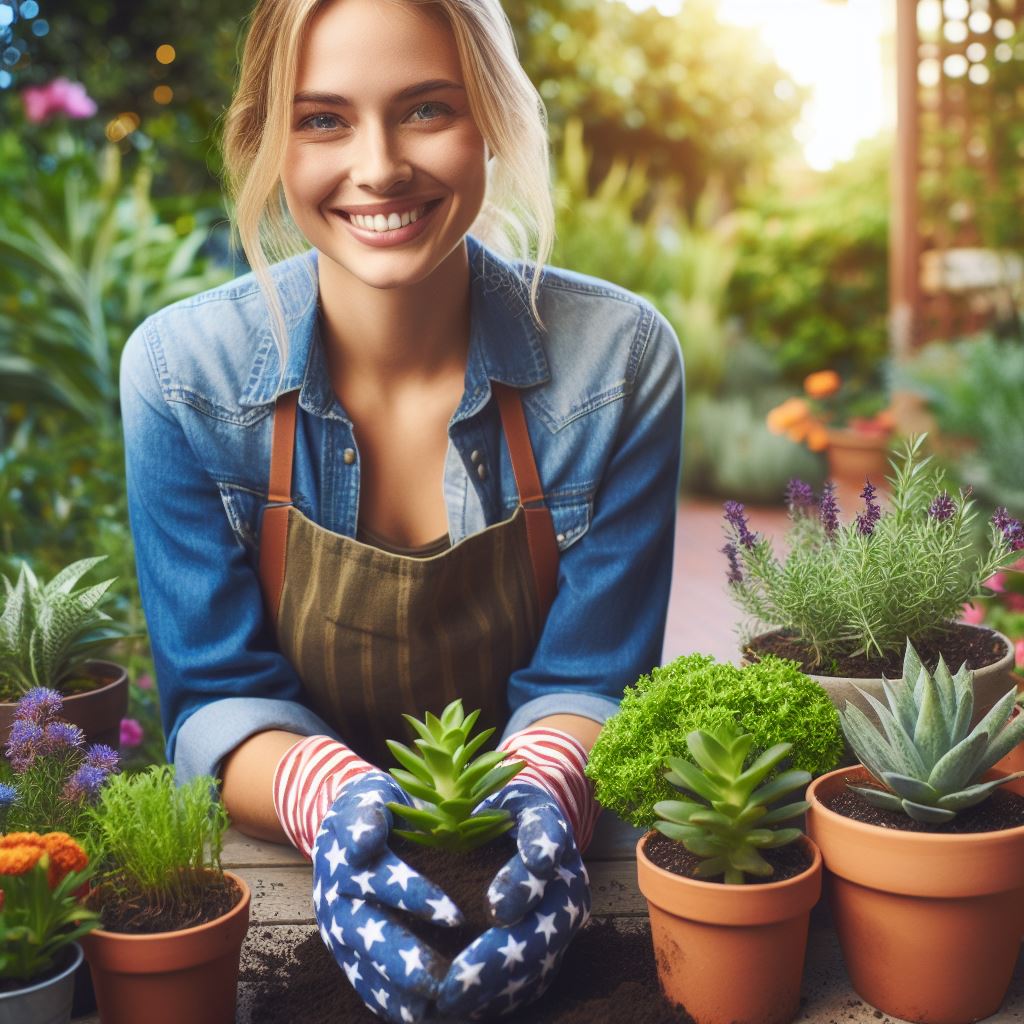Starting Organic Gardens: A Beginner’s Guide
Last Updated on March 2, 2024
Introduction
Gardening has gained popularity as people understand the importance of growing their own organic food.
This guide aims to help beginners start their own organic gardens.
The steps include choosing the location, preparing the soil, selecting plants, and implementing organic pest control methods.
Gardening is a rewarding and sustainable practice that allows individuals to have fresh and healthy produce right at their doorstep.
Organic gardening not only ensures chemical-free food but also promotes biodiversity and protects the environment.
By following this guide, beginners will gain the confidence to grow their own food and contribute to a healthier and more sustainable lifestyle.
Understanding Organic Gardening
Definition of organic gardening
One of the key aspects of organic gardening is the exclusion of synthetic chemicals and pesticides in the cultivation of plants.
Organic gardening focuses on utilizing natural methods and materials to promote the health and vitality of plants.
Benefits of organic gardening (environmental and health)
Environmental Benefits
- Organic gardening helps to preserve and protect biodiversity by creating a balanced ecosystem.
- It reduces pollution by avoiding the use of chemical pesticides and synthetic fertilizers.
- Organic gardening promotes sustainable agricultural practices, minimizing the depletion of resources and the impact on the environment.
Health Benefits
- Consuming organic fruits and vegetables offers higher nutrient content, flavor, and quality.
- Organic gardening eliminates the risk of chemical residue on food, reducing exposure to harmful toxins.
- Organic produce is free from genetically modified organisms (GMOs), ensuring a more natural and healthy diet.
Basic principles of organic gardening
Soil Health
- Organic gardening begins with building healthy soil through composting, mulching, and using natural amendments.
- Adding organic matter improves soil structure, enhances water retention, and provides essential nutrients for plant growth.
Crop Rotation
- Crop rotation is essential in preventing disease and pest buildup, as different plant families have varying vulnerabilities.
- By rotating crops each season, gardeners can disrupt disease cycles and reduce the need for chemical interventions.
Companion Planting
- Companion planting involves strategically placing compatible plants together to deter pests, attract beneficial insects, and enhance growth.
- Plants such as marigolds repel harmful pests, while herbs like basil can improve the flavor and overall health of neighboring plants.
Water Conservation
- Organic gardening emphasizes efficient water management by employing techniques like drip irrigation or rainwater harvesting.
- Mulching and proper watering practices help conserve water, reduce evaporation, and prevent weed growth.
Natural Pest Control
- Organic gardeners rely on natural pest control methods, such as introducing beneficial insects like ladybugs or using organic pest repellents.
- Encouraging biodiversity in the garden helps maintain a natural balance, preventing pest outbreaks.
Composting
- Composting is a key component of organic gardening, utilizing kitchen scraps, yard waste, and other organic materials to create nutrient-rich compost.
- Compost enriches the soil, improves its structure, and promotes microbial activity, benefiting plants and reducing the need for synthetic fertilizers.
Generally, organic gardening is an eco-friendly and health-conscious approach to cultivation.
By understanding the definition, benefits, and basic principles, beginners can embark on their organic gardening journey with confidence and reap the rewards of sustainable, nutritious, and vibrant harvests.
Read: Urban Permaculture: Sustainable Tips
Planning Your Organic Garden
Selecting the right location
- Choose an area with at least 6-8 hours of direct sunlight for your organic garden.
- Avoid places that are too close to trees or buildings, as they can block sunlight and provide too much shade.
- Make sure the location is easily accessible for watering, weeding, and harvesting.
- Consider the proximity to your house, as a garden that is closer will be easier to tend to.
Assessing sunlight and drainage
- Observe the area throughout the day to determine if it receives enough sunlight for your plants.
- Ensure that the location has good drainage to prevent waterlogging, which can lead to root rot.
- Check if there are any areas prone to flooding or excessive moisture, as this can also harm your plants.
- Consider the natural slope of the land to avoid water accumulation in the garden area.
Choosing the appropriate garden size
- Determine the amount of available space and choose a garden size that fits your needs and capabilities.
- A smaller garden may be more manageable for beginners who are just starting to learn about organic gardening.
- Consider the amount of time and effort you can dedicate to maintaining the garden before deciding on the size.
- Remember that a well-planned smaller garden can be just as productive as a larger one.
Considering the type of plants
- Research and choose plants that are suitable for your climate, soil type, and available sunlight.
- Consider the maintenance requirements of different plants, as some may need more attention and care.
- Think about the purpose of your garden – whether it’s for food, aesthetics, or a combination of both.
- Take into account the growth habits and potential size of the plants when planning the garden layout.
Creating a garden layout
- Sketch a rough plan of your garden to visualize the placement and arrangement of plants.
- Consider companion planting, which involves planting compatible plants together to maximize growth and deter pests.
- Allow enough space between plants to ensure good air circulation and prevent overcrowding.
- Group plants with similar water and sunlight requirements together for easier maintenance.
After selecting the right location with adequate sunlight, assessing drainage, choosing an appropriate garden size, considering the type of plants, and creating a garden layout, you will be well-prepared to start your organic gardening journey.
Remember to regularly monitor and care for your plants, maintain proper watering practices, and address any issues promptly to ensure a successful and thriving organic garden.
Read: Hydroponics: Gardening Without Soil
Preparing the Soil
A well-prepared soil is the foundation for a successful organic garden.
By testing and amending the soil with organic matter, as well as learning the basics of composting and mulching, you can create a rich and fertile environment for your plants to thrive.
Testing the soil
Before starting your organic garden, it is essential to test the soil to determine its pH level and nutrient content.
This can be done using a home soil testing kit or by sending a sample to a professional laboratory.
Testing allows you to understand your soil’s deficiencies and adjust accordingly.
Based on the test results, you can determine what amendments your soil may need, such as adding lime to raise pH or sulfur to lower it.
Additionally, you can identify which nutrients require supplementation, ensuring your plants have all they need to grow healthily.
Amending the soil with organic matter
One of the best ways to improve soil fertility is by incorporating organic matter.
This includes compost, well-rotted manure, leaf mold, and other decomposed plant materials.
Organic matter helps to loosen heavy soils, improve drainage in clay soils, and increase moisture retention in sandy soils.
To amend the soil, spread a 2- to 3-inch layer of organic matter over the garden bed and incorporate it into the top 6 to 8 inches of soil using a garden fork or tiller.
This not only adds valuable nutrients but also enhances soil structure and encourages beneficial soil organisms.
Composting basics
Composting is a natural process that breaks down organic materials into nutrient-rich humus.
By composting kitchen scraps, yard waste, and other plant materials, you can create your own free source of organic matter for the garden.
Begin your compost pile or bin by combining equal parts “greens” and “browns.”
Greens refer to nitrogen-rich materials like grass clippings and vegetable scraps, while browns include carbon-rich items such as dried leaves and straw.
Alternate layers of greens and browns, keeping the pile moist and aerated by turning it regularly.
Over time, the materials will decompose, and you can use the finished compost to amend the soil or make nutrient-rich compost tea for your plants.
Mulching options for soil improvement
Mulching is an excellent technique for soil improvement, as it helps retain moisture, suppresses weed growth, and moderates soil temperature.
Organic mulches, such as straw, compost, wood chips, or shredded leaves, provide additional organic matter as they break down.
Apply a layer of mulch around your plants, leaving a small space around the stems to prevent moisture buildup and potential disease.
Mulch should be 2 to 3 inches thick and replenished as needed to maintain its effectiveness. As it decomposes, it will enhance soil fertility and structure.
Essentially, preparing the soil for your organic garden involves testing its pH and nutrient levels, amending it with organic matter, mastering the art of composting, and utilizing mulches for soil improvement.
By investing time and effort into soil preparation, you are setting the stage for a productive and thriving organic garden.
Read: Apartment Aquaponics: Fish & Plants
Selecting Organic Seeds and Plants
Importance of using certified organic seeds and seedlings
- Choose certified organic seeds to ensure they are free from pesticides and genetically modified organisms.
- Using organic seeds supports sustainable farming practices and preserves biodiversity in our food supply.
- Organic seeds have higher nutritional value, which benefits both your health and the environment.
- By using certified organic seedlings, you can be confident that no synthetic fertilizers or chemicals were used in their production.
Finding local suppliers or nurseries
- Search for local organic seed suppliers or nurseries that specialize in organic plants.
- Visit farmer’s markets, community gardens, or join organic gardening groups to connect with local suppliers.
- Check online directories or organic gardening forums for recommendations on trustworthy local suppliers.
- Ask friends, neighbors, or fellow gardeners for their preferred sources of organic seeds and plants.
Differences between heirloom and hybrid varieties
- Heirloom varieties are open-pollinated, preserving their unique traits over generations.
- Hybrid varieties are the result of controlled cross-pollination between different plant varieties.
- Heirloom seeds can be saved and replanted each year, maintaining their characteristics.
- Hybrid seeds may not produce the same traits in subsequent generations, requiring new seeds to be purchased.
Tips for starting seeds indoors
- Choose a warm, well-lit area to set up your indoor seed starting station.
- Use organic seed starting soil mix to ensure optimal germination and growth.
- Label your seed trays or pots to keep track of the different plant varieties.
- Provide adequate moisture and ventilation to prevent mold or damping-off disease.
- Transplant seedlings into larger pots once they have developed a few sets of true leaves.
- Harden off your seedlings before transplanting them outdoors to help them acclimate to the outdoor conditions gradually.
In general, selecting the right organic seeds and seedlings is a crucial step in starting your organic garden.
By using certified organic seeds, you support sustainable farming practices and ensure a healthy and environmentally friendly garden.
Finding local suppliers or nurseries specializing in organic plants helps you access high-quality seedlings and support your community.
Understanding the differences between heirloom and hybrid varieties allows you to make informed choices about the plants you grow.
And following tips for starting seeds indoors ensures successful germination and healthy growth. Happy gardening!
Read: DIY Urban Greenhouse: Step-by-Step

Planting Techniques
Determine Appropriate Planting Time
- Research the recommended planting time for each vegetable or plant you wish to grow.
- Consider your local climate and the specific needs of each plant.
- Consult gardening resources or experts to determine the ideal timing for planting in your area.
Proper Spacing and Depth
- Follow the instructions provided on seed packets or plant labels for recommended spacing between plants.
- Use a ruler or measuring tape to ensure accurate spacing.
- Dig holes or furrows of the appropriate depth, as specified for each type of plant.
- Gently place the seeds or seedlings into the holes at the correct depth, ensuring good soil contact.
Watering Techniques for Newly Planted Seeds and Seedlings
- Water the soil before planting to ensure it is moist but not waterlogged.
- After planting seeds, water gently to avoid displacing them or disturbing the soil.
- For seedlings, water thoroughly but avoid over-watering to prevent root rot.
- Consider using a watering can with a fine spray, or a hose with a soft nozzle attachment, for delicate young plants.
Transplanting Tips for More Mature Plants
- Choose a calm, overcast day to minimize stress on the plants during the transplanting process.
- Prepare the new location by loosening the soil and adding compost or organic matter if necessary.
- Dig a hole slightly larger than the plant’s root ball and gently remove the plant from its original container.
- Place the plant into the hole, ensuring it is at the same depth as it was previously.
- Backfill the hole with soil, gently firming it around the plant’s roots.
- Water the transplanted plant thoroughly to help settle the soil and reduce air pockets.
By following these planting techniques, you can give your organic garden the best start possible.
Proper timing, spacing, and watering are essential for successful plant growth.
Whether you are sowing seeds or transplanting seedlings, taking care to provide the right conditions will help your plants thrive.
Remember to adjust your planting time according to your specific climate and growing conditions.
Don’t be afraid to ask for advice from local gardeners or consult gardening resources for more detailed information on specific plants.
With time and practice, you will become more experienced in planting techniques and achieve bountiful organic harvests in your garden.
Organic Pest and Weed Control
Prevention methods
- Keep your garden clean and free of debris to reduce pest hiding places.
- Practice crop rotation to prevent pests from building up in the soil.
- Use netting or row covers to physically block pests from reaching your plants.
- Remove any infected or diseased plants promptly to prevent the spread of pests.
Natural pest control options
- Introduce beneficial insects, such as ladybugs and lacewings, to control pests naturally.
- Use organic insecticides like neem oil, pyrethrin, or insecticidal soap, which are less harmful to the environment.
- Make homemade pest repellents using garlic, chili pepper, or soapy water to deter pests.
- Install birdhouses or birdbaths to attract birds that feed on garden pests.
Companion planting for pest management
- Plant aromatic herbs like basil, rosemary, or mint near vulnerable plants to repel pests.
- Interplant flowers like marigolds, nasturtiums, or zinnias to attract beneficial insects that prey on pests.
- Grow trap crops like radishes or lettuce to lure pests away from your main crops.
- Avoid monocultures and mix different plant species to confuse and discourage pests.
Strategies for weed control without chemicals
- Mulch your garden beds with organic materials like straw, wood chips, or shredded leaves to suppress weeds.
- Hand pull weeds regularly, ensuring you remove both the roots and aerial parts.
- Use a hoe or cultivator to disrupt weed growth and expose their roots to dry out.
- Opt for manual weed control methods, such as flame weeding or vinegar-based herbicides.
In essence, organic pest and weed control in your garden doesn’t have to rely on harmful chemicals.
By implementing prevention methods, using natural pest control options, practicing companion planting, and employing strategies for chemical-free weed control, you can create a healthy and thriving organic garden.
Remember, a balanced ecosystem with diverse plant species and beneficial insects is the key to long-term pest and weed management.
Nurturing Your Organic Garden
In order to ensure the success of your organic garden, it is important to give your plants the proper care and attention they need.
This section will provide you with guidelines on watering, fertilizing, monitoring growth and health, as well as troubleshooting common gardening issues organically.
Watering guidelines for healthy plants
- Water your plants deeply and infrequently to encourage deep root growth.
- Avoid overwatering, as it can lead to root rot and other fungal diseases.
- Water in the early morning or late afternoon to minimize evaporation.
- Utilize mulch to retain moisture and reduce the need for frequent watering.
- Use a rain gauge to measure rainfall and only water if needed.
- Make sure to water the soil directly, avoiding the leaves to prevent disease.
Fertilizing with organic options
- Use compost as a natural and nutrient-rich fertilizer for your organic garden.
- Incorporate organic matter into the soil to improve its fertility and structure.
- Consider using natural fertilizers such as bone meal, fish emulsion, or seaweed extract.
- Apply fertilizers sparingly to avoid nutrient imbalances and burning of plants.
- Follow the recommended application rates provided by the manufacturer.
- Regularly monitor the nutrient levels in your soil and adjust fertilization accordingly.
Monitoring plant growth and health
- Regularly inspect your plants for signs of pests, diseases, or nutrient deficiencies.
- Keep a gardening journal to track the progress of your plants and identify any patterns or issues.
- Prune and trim your plants as needed to promote healthy growth and prevent overcrowding.
- Use companion planting to attract beneficial insects and deter harmful pests.
- Monitor the weather conditions and provide protection for your plants during extreme temperatures or storms.
- Install stakes or trellises to support tall plants and prevent them from toppling over.
Troubleshooting common gardening issues organically
- Combat pests naturally by introducing beneficial insects such as ladybugs or releasing nematodes.
- Use organic pest control methods like insecticidal soaps, neem oil, or garlic sprays.
- Practice crop rotation to prevent the build-up of pests and diseases in the soil.
- Remove weeds manually or through organic weed control methods like mulching or hoeing.
- Identify the cause of plant diseases and address them with organic fungicides or cultural practices.
- Seek advice from local gardening experts or join gardening communities for further support and guidance.
By following these guidelines for nurturing your organic garden, you can ensure a healthy and thriving ecosystem for your plants.
Remember to be observant, proactive, and open to learning and adapting your approach as needed. Happy gardening!
See Related Content: Essential Soil Management Tools Explained
Harvesting and Storing Organic Produce
Knowing when to harvest
- Observe the color, size, and texture of the produce to determine if it’s ripe.
- Check for the specific harvesting time recommended for each type of fruit or vegetable.
- Look for signs of maturity, such as full color, firmness, and a sweet smell.
- Harvest leafy greens, like lettuce or kale, when they have reached the desired size.
Proper harvesting techniques
- Use clean and sharp garden shears or a knife to cut the stem of the produce.
- Handle the produce gently to avoid bruising or damaging it.
- Leave a small portion of the stem intact to help preserve the quality of the harvested produce.
- Harvest early in the morning when the temperature is cooler to maintain freshness.
Storing fruits and vegetables without chemicals:
- Store organic produce separately from non-organic produce to prevent cross-contamination.
- Use organic-approved storage containers, such as glass jars or BPA-free plastic containers.
- Avoid using plastic bags, as they can cause moisture buildup and lead to spoilage.
- Wrap delicate produce, like berries, in paper towels to absorb excess moisture and extend their shelf life.
Maximizing the shelf-life of harvested produce
- Remove any damaged or rotten pieces to prevent them from spoiling other produce.
- Store fruits and vegetables in a cool, dark, and well-ventilated place to slow down the ripening process.
- Avoid storing produce near ethylene-producing fruits, like bananas, as they can speed up ripening.
- Consider preserving produce through freezing, canning, or dehydrating to enjoy them for longer periods.
By learning when to harvest, using proper techniques, and implementing effective storage methods, you can enjoy the full benefits of organic gardening by consuming fresh and chemical-free produce.
Conclusion
Recap of key points discussed in the guide
Throughout this beginner’s guide to starting organic gardens, we have covered important aspects such as selecting the right location, preparing the soil, choosing organic seeds, and managing pests naturally.
We have emphasized the significance of proper watering, weed control, and mulching.
Encouragement for beginners to start their organic gardens
For those just starting out, don’t be intimidated!
Organic gardening is a rewarding and fulfilling activity that anyone can enjoy.
With proper planning, dedication, and patience, your garden will thrive and provide you with delicious, nutritious produce.
Final thoughts on the benefits of organic gardening
Organic gardening offers numerous advantages, including better-tasting and healthier fruits and vegetables, reduced environmental impact, and the opportunity to reconnect with nature.
By nurturing your garden without synthetic chemicals, you are contributing to a sustainable and greener future.
In a nutshell, starting an organic garden is a journey that begins with small steps but leads to a lifetime of joy and fulfillment.
Remember, every effort you put into your garden will yield abundant rewards for you, your loved ones, and the planet.
Don’t wait any longer, grab your tools and start creating your own organic oasis!


